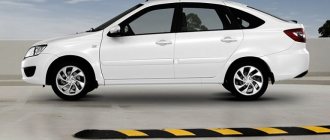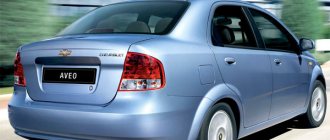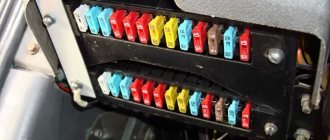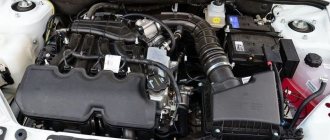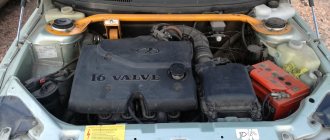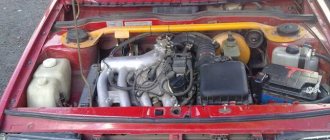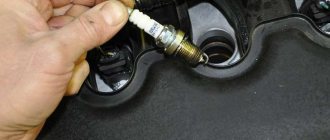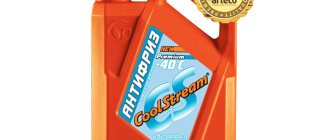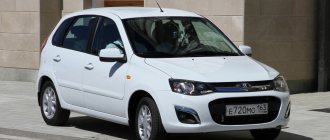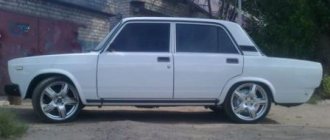Owner reviews
- Igor, Irkutsk. A great workhorse for getting from point A to point B. A comfortable classic sedan, spacious inside and practical. The car handles quite predictably, but rolls a lot. This is understandable, given the soft suspension and ground clearance of 170 mm. Now the mileage is 115 thousand kilometers. The machine works excellently on the plains and in the mountains, as well as on rough terrain. The sedan is ideal for country roads - it is unlikely that an alternative to it for such conditions can be found. I don’t even mind damaging it or breaking it – the car is so cheap to maintain. As for the quality of workmanship, safety, finishing materials, this is a completely different conversation. The car is completely worth the money, at least when I bought it - it was in the late 1990s.
- Alexey, Yaroslavl. I have a 2011 sedan. The car is equipped with a 1.6-liter engine with 74 horsepower. Nothing unusual. Currently the mileage is 46 thousand kilometers. I travel quite rarely. I like the VAZ-2107, this is my first car. Despite the outdated design and uncomfortable driving position, even a novice user can quickly get used to driving this car. Over the entire period of operation, it was necessary to replace the rear axle oil seal, the main brake cylinder, as well as the rear brake cylinders. These are the main major problems. Replacing consumables, fuel and oil - all this goes without saying. Ground clearance is 170 mm, like most modern crossovers. The car is rear-wheel drive, with excellent cross-country ability, soft and comfortable suspension. When making fast turns, the car rolls a lot, which is to be expected given the age of the car. Fuel consumption with a 1.6 engine is 10 liters.
- Yuri, Novosibirsk. I bought a VAZ-2107 in 2005. I have a version with a carburetor engine. The rear window is tinted with mesh, as was previously fashionable. There is also simple music, the body is painted in Baltika 420 color. At the moment, the mileage is 115 thousand kilometers. Two years ago I replaced the battery and fuse. Also, during the entire period of use, various components were replaced - front brakes, clutch (replaced with a Nivovsky one), muffler, shock absorbers, steering rod bracket, cooling system and heater. Over the past 10 months I have been driving the car without any major breakdowns, since all the most important parts are new. In the mixed driving cycle, the car consumes 8 liters per 100 km. I installed the DRL and connected it via a 5-pin relay from the dimensions. Switching between high and low beam is now much easier. The vehicle's cross-country ability is at a high level, even better than some single-wheel drive crossovers. This is due in no small part to the ground clearance of 170 mm, as well as the energy-intensive suspension.
- Dmitry, Penza. I have been using the car since 2016. The car is manufactured in 2011. Total mileage is 78 thousand kilometers. Breakdowns occur at intervals of two to three times a week. The car supposedly underwent pre-sale preparation, but already 3 thousand km after purchase the main gear oil seal suddenly leaked. I adjusted all the doors, tightened the upper arms in the suspension, but the knocking still persisted. We also had to replace the thermostat, which was stuck open. There are problems with the tightness of the hoses. I'm thinking of replacing them with polyethylene hoses with Euro connectors. The machine is used every day. The seven has a spacious trunk, three tall passengers can fit in the back seat, but it’s not very comfortable to sit - the seat is very soft, and it’s like you’re falling into it. The suspension is energy-intensive. The car drives great on rough roads, you don’t even need to slow down much.
Geometric parameters of the car
The car has a monocoque three-volume sedan-type body in the classic version. The engine compartment is located in the front part, the closed passenger compartment is in the middle, and the trunk is located at the rear. There are 4 doors for the driver and passengers to enter; the engine compartment is closed by a hood that rises forward. This scheme has become most widespread in the automotive industry as the most successful.
The table of dimensions of the VAZ 2107 car is given in the technical documentation; the main parameters are:
| total length at the extreme points of the bumpers | 4145 mm |
| greatest width: along the door shirts | 1620 mm |
| greatest width: according to rear view mirrors | 1740 mm |
| base - the distance between the wheel axles | 2424 mm |
| vehicle height without antenna | 1446 mm |
| ground clearance | 120 mm |
| for vehicles equipped with a neutralizer | 90 mm |
| distance between the center lines of the wheels in front | 1365 mm |
| rear wheel center distance | rear 1321 mm |
A detailed diagram with precise indication of linear dimensions is indicated in the official publication of the vehicle operating instructions.
Characteristics of VAZ 2107
VAZ-2107 Zhiguli/Lada 1500SL/Lada Riva (“seven”) is a rear-wheel drive four-door sedan produced by the Volzhsky Automobile Plant with an improved external design. At one time, this car earned the name “Russian Mercedes” in the southern republics of the former Soviet Union for its characteristic appearance. The car was created on the basis of the base model of the family - the VAZ 2105. Just as the “six” was once considered more prestigious than the VAZ-2103, so the VAZ-2107 Zhiguli/Lada 1500SL/Lada Riva (“seven”), produced since 1982, is compared with the “five” was exclusive in itself. On the other hand, the designers quite justifiably designed a “luxury” version of it based on the purely “utilitarian look” of a small car that was cheap to produce. The differences are already noticeable in appearance: a different design for the front part of the hood with stamping to match the metal chrome radiator grille (under which the hood rusts beautifully), new rear block lights. Inside, the car was fully consistent with the then ideas about modern aesthetics (early 1980s): a “glare-free” instrument panel with a tachometer, additional service sensors and instruments. Anatomical seats with improved finishing quality look more solid compared to the same type of VAZ-2105: the front backrests are made integral with headrests, and the rear backrest has a special folding armrest. But for such equipment, sellers (and previously the state) ask for a larger amount than even for the classic VAZ-2106 or the front-wheel drive three-door hatchback VAZ-2108. The “Seven” has improved passive safety, good all-round visibility, limited, however, by the rear pillars and high seat backs, but the advantages of dynamic engines are negated by poor assembly and the lack of anti-corrosion coating on the body. The scourge of all rear-wheel drive Zhigulis is also depressing - the high loading height of the trunk, problems with the engine block, broken camshaft belts and loose bolted joints of cars produced between 1990 and 1996.
Initially, VAZ-2107, -21072, -21074 cars were equipped with four-cylinder carburetor engines of models 2103, 2105 and 2106, respectively. These engines can be found with unified (since 1987) four- and five-speed (VAZ-2112) gearboxes. The five-speed gearbox for the VAZ-21074 was slightly modernized in 1992. Since 1990, engines have been equipped with connecting rods of a new design, and four years later, VAZ-21011 engines with a camshaft chain drive began to be installed on the less common modification of the VAZ-21072. All engines for the “Seven” since 1995 are not equipped with a PC-492 breaker relay, which can be determined when braking with the parking brake by the constant glow of its indicator lamp.
For the European market, in accordance with environmental protection requirements, the VAZ-21073 sedan has been produced since 1991, equipped with a 1.7-liter engine producing 84 hp. with central injection system and catalytic converter. For the Chinese market, the VAZ-2107 model of the N71 series was produced with a 66-horsepower 1.45-liter short-stroke VAZ-21033-10 engine running on A-76 gasoline (the other “sevens” only run on gasoline with an octane rating of at least 91). Also, on special orders, the plant produces expensive VAZ-21079 sedans with a high-speed Wankel rotary piston engine, which, if it breaks down, is very rare. True, in this case it can only be repaired at a VAZ branded service center. Ordinary consumers probably don’t need such a voracious and unstable car at high speeds. The spring suspension of all wheels is quite energy-intensive and comfortable when driving. However, creaks of the instrument panel, outdated ergonomics of the workspace, and non-linear coasting (with little information steering, you constantly have to control the trajectory of movement) are annoying. Large and uneven gaps between the panels of the doors, hood and body - these problems widen over time due to the natural wear and tear of the car and fatigue damage and deformation of the power elements of the body.
Sellers pass off many of the cars sold on the market as re-exported, pointing to the marking with the letter E on the headlights, windows, tires, rear-view mirrors or the car's nameplate. However, the letter E was placed at the factory after special homologation tests, and the number after the letter indicates the country whose rules these components and assemblies comply with: 1 - Germany (Germany); 2 - France; 3 - Italy; 8 - Czechoslovakia, etc. It is also not recommended to purchase cars older than eight years (since 1990). In general, the VAZ-2107 can rightfully be called the most advanced and comfortable rear-wheel drive domestic sedan, besides, quite a lot of different companies are engaged in tuning “VAZ” models, and the “Seven” can be equipped with all the bells and whistles that increase comfort or dynamics, and for “just ridiculous money” "compared to foreign cars.
Since 2001, a new model configuration program was adopted, for the VAZ 2107 model there were versions - “standard” and “norm”, for the VAZ 21074 - “norm” and “luxury”.
What engine can be installed on this car?
Initially, 2 types of engines were installed on the VAZ 2107 model, these are:
- VAZ 2103, with a working volume of 1.5 liters
- VAZ 2106, with a working volume of 1.6 liters
Let's look at them next.
There were also 1.3 L and 1.2 L engines, but they are very few in number and practically never found.
It is also possible to install an engine from a VAZ with front-wheel drive, but it is too labor-intensive and unjustified.
This is interesting! Sometimes the English letter “i” is added before the name of the car. This means that the VAZ 2107 engine is an injector.
Injector – fuel sprayer. Nozzle. The principle of operation of injection gasoline engines is very similar to diesel engines.
What should be the consumption for a VAZ 2107 carburetor?
Average consumption
fuel for a
VAZ 2107
with
carburetor
is 11.2 liters on city roads and 6.5 liters on highways and highways.
Interesting materials:
How to remove night mode in WhatsApp? How to remove the page number in Word on the second page? How to remove nasolabial folds with a spoon? How to remove News in Google Chrome? How to remove the news feed on the lock screen? How to remove numbering from two pages? How to remove surround sound? How to remove the cloud from the App Store? How to remove the Imovie update? How to remove updates when you turn off your computer?
Engine VAZ 2106
The design of the VAZ 2106 engine is almost completely identical to the VAZ 2103 engine, with the exception of some nuances, such as engine displacement.
Characteristics
| Year of production of engines of this type | 1976 – our time |
| Supply system | Injector/carburetor |
| engine's type | Row |
| Number of pistons | 4 |
| Cylinder block material | cast iron |
| Cylinder head material | aluminum |
| Number of valves per cylinder | 2 |
| Piston stroke | 80 mm |
| Cylinder diameter | 79 mm |
| Engine capacity | 1569 cm 3 |
| Power | 75 l. With. at 5400 rpm. |
| Maximum torque | 116 Nm at 3000 rpm. |
| Fuel consumption (100 km): | 10.3 l |
| city | 7.4 l |
| track | 10 l |
| mixed |
Dimensions and Weight are identical (see paragraph Characteristics of the VAZ 2103 engine).
Features of operation
Completely identical to the VAZ 2103 engine (see similar VAZ 2103 engine design). The oil volume in the crankcase is also the same and is 3.75 liters.
Engine tuning
Also identical to the VAZ 2103 engine. See the section Engine tuning (VAZ 2103). The features of boring will be described below.
- Increase in working volume
Identical to the point “Increasing the displacement of the VAZ 2103 engine” with the exception that this engine does not require sharpening the cylinder block. It has already been bored to the required values.
This concludes the article. We hope that you were interested and found answers to the questions: “What engine can be installed in my car?”, “How to increase engine power without losing reliability?” and “What is an injector?” As you can see, despite its modest engine performance, the VAZ 2107 has the potential for modernization and in terms of speed characteristics it can be on par with modern cars.
Differences between cars of recent years [edit | edit code]
In cars of the last years of production (under the state car recycling program), in order to minimize the selling price, the maximum cost of elements was made relative to previously produced equipment. What we noticed: there are no ashtrays in the rear door trim; interior door handles are made of molded hard plastic (instead of rubberized material); There are no clothes hooks on the ceiling handrails; one weak and capricious sound signal “tablet” was used, instead of two “horns”. The 2010 car was not equipped with a pump. In addition, changes affected the appearance of the “seven”. Instead of a flat trunk lid, a lid with stamping from a VAZ-2105 appeared, and the plastic molding at the bottom of the body disappeared. They refused to paint the door pillars and frames black, and they abandoned the chrome-plated external door handles. Headlight washers and cleaners were no longer installed on cars of recent years of production.
